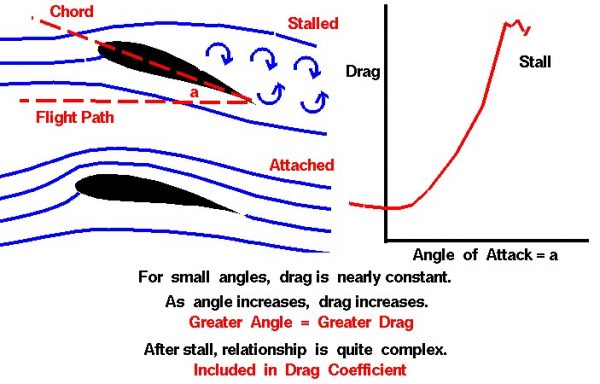Inclination Effects on Drag
Angle of Attack
As a wing moves through the air, the airfoil is inclined to the flight direction at an angle. The angle between the chord line and the flight direction is called the angle of attack and has a large effect on the drag generated by the wing.
Boundary Layer
The magnitude of the drag generated by an object depends on the shape of the object and how it moves through the air. For thin airfoils, the drag is nearly constant at small angles (+/- 5 degrees). As the angle increases above 5 degrees, the drag quickly rises because of increased frontal area and increased boundary layer thickness. As an object moves through the air, air molecules stick to the surface. This creates a layer of air near the surface called a boundary layer which, in effect, changes the shape of the object. The flow reacts to the edge of the boundary layer just as it would to the physical surface of the object. To make things more confusing, the boundary layer may lift off or “separate” from the body and create an effective shape much different from the physical shape. When the boundary layer separates, the wing is said to be stalled and both drag and lift become unsteady. Determining the drag is very difficult under stalled conditions.
Flow Conditions
On the slide, the flow conditions for two airfoils are shown on the left. The shape of the two foils is the same; the lower foil is inclined at ten degrees to the incoming flow, while the upper foil is inclined at twenty degrees. On the upper foil, the boundary layer has separated and the wing is stalled. Predicting the stall point, the angle at which the wing stalls, is very difficult mathematically. Engineers usually rely on wind tunnel tests to determine the stall point. But the test must be done very carefully, matching all the important similarity parameters. of the actual flight hardware.
Plot
The plot at the right of the figure shows how the drag varies with angle of attack for a typical thin airfoil. At low angles, the drag is nearly constant. Notice on this plot that at zero angle, a small amount of drag is generated because of skin friction and the airfoil shape. At the right of the curve, the drag changes rather abruptly and the curve stops. In reality, you can set the airfoil at any angle you want. However, once the wing stalls, the flow becomes highly unsteady and the value of the drag changes rapidly with time. Because it is so hard to measure such flow conditions, engineers usually leave the plot blank beyond wing stall.
Lift Coefficient
Since the amount of drag generated at zero angle and the location of the stall point must usually be determined experimentally, aerodynamicists include the effects of inclination in the drag coefficient. But this presents an additional problem. There is another factor which affects the amount of drag produced by a finite wing. The effect is called induced drag or drag due to lift. The flow around the wing tips of a finite wing create an “induced” angle of attack on the wing near the tips. As the angle increases, the lift coefficient increases and this changes the amount of the induced drag. To separate the effects of angle of attack on drag, and drag due to lift, aerodynamicists often use two wing models. The wing model to determine angle of attack effects is long and thin, and may span the entire tunnel to produce a “two-dimensional” airfoil. Another model is used to determine the effects of the wing tips on the drag.

